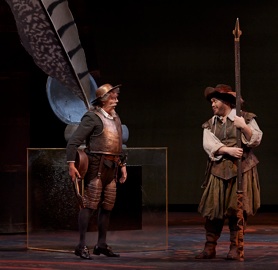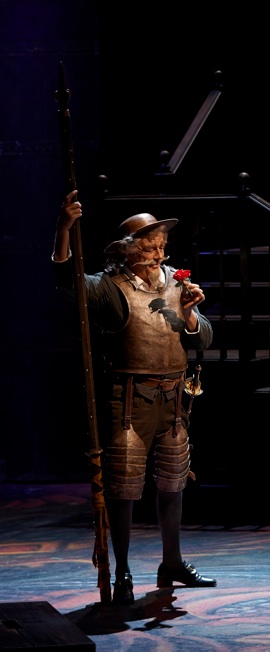Reviews 2014






✭✭✭✭✩
by Jules Massenet, directed by Linda Brovsky
Canadian Opera Company, Four Seasons Centre, Toronto
May 9-24, 2014
Dulcinée: “Les plus illustres faits des héros de jadis
Sont ici dépassés, même ceux d'Amadis!”
The Canadian Opera Company’s first-ever presentation of Jules Massenet’s Don Quichotte is beautiful, both musically and visually. In Ferruccio Furlanetto, the production has the foremost proponent of the role in the world, but he is surrounded by a cast of an equally high level. The orchestral playing under conductor Johannes Debus is gorgeous. And the whimsical directorial concept, for a change, enhances the story rather than detracts from it. It is hard to believe you could find a more sympathetic production of this operatic rarity anywhere.
Don Quichotte (1910) is one of the last of the 29 extant operas by Massenet (1842-1912), who is best known for his Manon of 1884 and his Werther of 1892. Up to now these have been the only operas the COC has ever presented – Manon in 1952 and Werther in 1980 and 1992. Don Quichotte is thus the first opera by Massenet the COC has presented in 22 years, and it was a delight to hear his colourful soundworld emanating from the pit and stage after so long an absence.
The opera itself is rather peculiar owning to its subject matter and the circumstances of its composition. To create a libretto from a novel of about 1000 pages, Henri Caïn chooses two simple incidents. Don Quichotte’s beloved Dulcinée, now no longer a simple farm-girl but a sophisticated flirt, asked the aged knight to retrieve a necklace stolen by thief Ténébrun. The knight and his trusty companion Sancho Panza set out and encounter windmills that the knight mistakes for giants. He does retrieve the necklace from the bandits and returns it to Dulcinée. As a reward he expects her to consent to marry him. When she laughingly turns him down it breaks his heart.

Besides providing the rare chance for a bass to star in an opera, the main strength of Don Quichotte is its mood. Dulcinée laments that she is no longer young. Don Quichotte laments that he has outlived the age of chivalry. Even at its most joyous, there is a sense of melancholy to the music as if we were witnessing the dying of an age. Massenet himself was writing in a style at the very end of romanticism and the Spanish couleur locale he evokes in the opera sounds very much like Bizet’s Carmen of 35 years earlier or like his own opera Le Cid of 25 years earlier. The opera becomes not just a lament for the passing of Don Quichotte, but for the passing of the of the whole age of idealism as it entered the 20th century.
In Cervantes’ original novel Don Quixote went mad from reading too many tales of chivalric romances like Tiran lo Blanch (1490) or Amadis de Gaula (1508). Under Linda Brovsky’s inspired direction, Donald Eastman’s delightful set created for Seattle Opera consists of gigantic leather-bound volumes of these romances and items like inkwells with quills and a blotting powder shaker that one might find on a 17th-century desk. Simple rearrangements of the books turns them from buildings on a town street to mountains to a forest. The blades of the windmill that Don Quichotte fights are the quills in the inkwells.
These volumes and the gorgeous period costumes designed by Canadian Christina Poddubiuk are all in autumnal tones that reinforce the theme of the summer of life and of an entire age having come to an end. Lighting designer Connie Yun similarly bathes the stage in golden hues of sunset and creates a beautiful starlit night for the final scene.

Quinn Kelsey, who was such a powerful Rigoletto here in 2011, has a chance to show off his comic side as Sancho Panza. He, too, avoids all cliché in this role. Given that the action takes place just before his master’s death, he shows that any arguments he and the knight have had are all in the past and all that remains is devotion and vigorous defence of his master. Kelsey has an equally large voice full of warmth. He brings off the comedy of Sancho’s tirade against women in “Comment peut-on penser du bien de ces coquines” and is deeply moving in the final scene.
Massenet’s Dulcinée is a kind of world-weary Carmen, who longs for the excitement of first love which has long since past. Anita Rachvelishvili has just the right contralto voice for the role – rich yet youthful and agile. She conveys the complex mixture of amusement and flattery that the knight’s devotion evokes. When she rejects his proposal and sees what pain it has caused the knight, she rushes to undo the damage although it is too late.
The rest of the roles are quite small, but Michel Corbeil deserves mention for his excellent performance in the speaking role of the Bandit Chief who is so struck by the aged knight’s belief that he completely reverses his initial attitude of mockery to one of reverence.
Conductor Johannes Debus leads the COC Orchestra in a sparkling account of the score that brings out with real panache its vibrant, ever-changing colours. Don Quichotte may not be one of the great masterpieces of opera, but it is certainly worth reviving when one of the great basses it at hand to play the title role. We have to be grateful to the COC for bringing this opera and this production to us, and we can only hope that there will be more Massenet in the future.
©Christopher Hoile
Note: A version of this review will appear in Opera News later this year.
Photos: (from top) The cast of Don Quichotte, Ferruccio Furlanetto on a horse; Ferruccio Furlanetto as Don Quichotte and Quinn Kelsey as Sancho Panza; Ferruccio Furlanetto. ©2014 Michael Cooper.
For tickets, visit www.coc.ca.
2014-05-10



Don Quichotte





